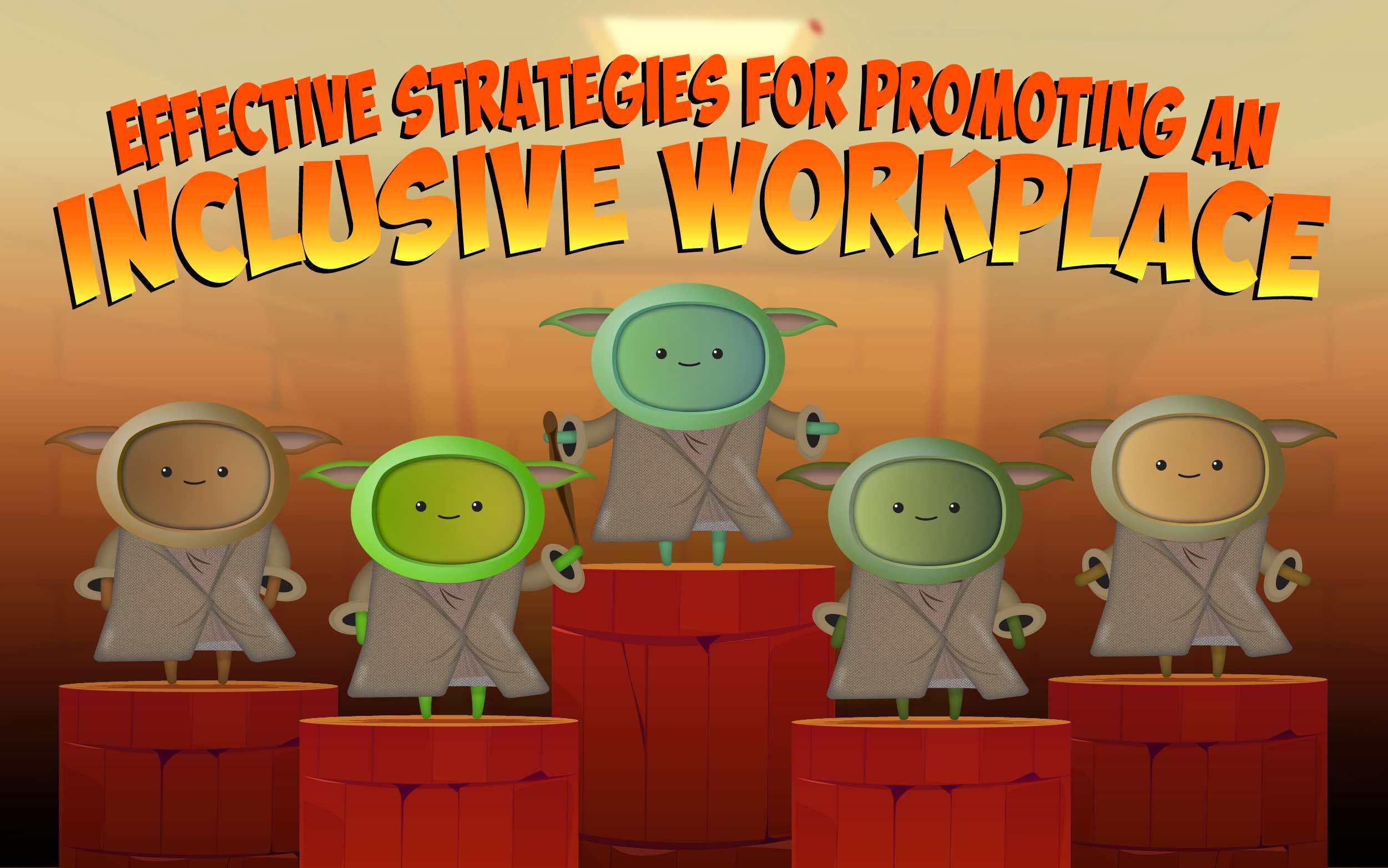Everyone has experienced feeling out of place at work at some point. Perhaps their brilliant idea has gone unnoticed simply because of their gender. Or maybe they’ve picked up on an invisible divide between different cultures in the office, and feel trapped or pressured to conform.
Inclusivity in the workplace is more than a buzzword; it's a fundamental aspect of a thriving, dynamic, and successful organisation. Inclusivity means creating an environment where all employees, regardless of their background, feel valued, respected, and empowered to contribute their best work. It encompasses equality, diversity, and inclusivity (EDI) efforts, ensuring that everyone has equal opportunities to succeed. This article explores why inclusivity is crucial, outlines 8 effective strategies to promote it, and demonstrates how adopting an inclusive workplace can benefit both employees and the business.
To fully understand inclusion, you’ll need to grasp the meanings and nuances behind equality, equity, and diversity.
Equality involves the fair treatment of everyone and is often associated with the UK's legislative framework, particularly The Equality Act 2010.
Equity focuses on creating equal outcomes for all, recognising that individuals may face significant barriers despite their effort and merit.
Diversity refers to the mix of people within an organisation. Inclusion, then, is the culture that enables this diverse group to work comfortably and confidently, being themselves and contributing effectively. An inclusive environment ensures that everyone feels valued and can add value to the business or service.
Why is Inclusivity so Important?
Inclusivity is vital for several reasons. It creates a safe and welcoming environment, making employees feel comfortable and empowered to reach their full potential. An inclusive workplace supports employee engagement, satisfaction, and retention, which are all essential for a company's success. More than that, a diverse and inclusive workforce brings different perspectives, encouraging innovation and better decision-making. By implementing a robust EDI strategy, businesses can ensure that all employees can participate and thrive, and that ultimately benefits the organisation, too.
1. Enhanced Creativity and InnovationAn inclusive workplace brings together people from diverse backgrounds, each offering unique perspectives and ideas. This diversity of thought promotes creativity and innovation, enabling the organisation to solve problems more effectively and develop novel solutions that a team without much variety might overlook.
2. Improved Employee Engagement and Satisfaction
When employees feel included and valued, their engagement and job satisfaction increase. Inclusive workplaces encourage open communication, collaboration, and a sense of belonging, which leads to higher morale and reduced turnover. Satisfied employees are more likely to be productive, committed, and motivated to contribute to the organisation's success.
3. Greater Talent Attraction and Retention
Companies that prioritise inclusivity are more attractive to top talent. Job seekers increasingly look for employers with strong diversity and inclusion (D&I) values. By promoting an inclusive culture, organisations can draw from a wider talent pool and retain skilled employees who feel respected and appreciated, thereby reducing recruitment and training costs.
4. Enhanced Company Reputation
A commitment to inclusivity can significantly boost a company's reputation. Businesses known for their inclusive practices are more likely to earn the trust and loyalty of customers, clients, and partners. Positive public perception can lead to increased market share, brand loyalty, and competitive advantage.
5. Better Decision-Making
Inclusive teams make better decisions. Diverse groups are more likely to consider a broader range of perspectives and potential solutions, leading to more informed and effective decision-making. Inclusivity helps mitigate ‘groupthink’, ensuring that decisions are well-rounded and consider various viewpoints.
6. Compliance and Risk Management
Adhering to inclusivity standards helps organisations comply with legal and regulatory requirements related to equality and discrimination. By adopting an inclusive environment, companies can reduce the risk of legal issues and enhance their ability to manage risks related to employee relations.
7. Reflective of Global Markets
In today's global economy, having an inclusive workplace that reflects the diversity of the market is crucial. Companies with diverse and inclusive teams are better equipped to understand and serve a varied customer base, making them more adaptable and competitive in global markets.
8. Ethical and Social Responsibility
Promoting inclusivity aligns with broader social and ethical responsibilities. It demonstrates a commitment to fairness, equity, and respect for all individuals, contributing to social progress and justice. Organisations that prioritise inclusivity play a role in creating a more equitable society.
Strategies to Promote an Inclusive Workplace
Creating an inclusive workplace requires intentional strategies and commitment. Here are several effective approaches to adopting an inclusive environment where all employees feel valued and empowered:
1. Develop a Comprehensive EDI Policy
A robust Equality, Diversity, and Inclusion (EDI) policy is the foundation of an inclusive workplace. This policy should outline the company's commitment to EDI principles, specific goals, and actionable steps to promote equality, diversity, and inclusivity. It should also include clear procedures for reporting and addressing discrimination or harassment. Regularly reviewing and updating the policy ensures it remains relevant and effective.
2. Offer Flexible Working Patterns
Flexible working arrangements are crucial for nurturing inclusivity. By offering options such as flexible hours, remote work, and varying work schedules, employers can accommodate the diverse needs of their workforce. This flexibility is particularly beneficial for parents, individuals with disabilities, and those with caregiving responsibilities. Providing such options helps employees balance their personal and professional lives, enabling them to perform at their best.
3. Use Inclusive Language in Job Descriptions
The recruitment process should reflect the company's commitment to inclusivity. Job descriptions should use inclusive language and avoid any biases that might deter qualified candidates. Highlighting the company's EDI efforts can attract a broader range of applicants. Additionally, making it clear that accommodations are available during the recruitment process can encourage more diverse candidates to apply.
4. Make Job Interviews Accessible
Ensuring that job interviews are accessible and accommodating is essential for inclusivity. This might include offering virtual interviews, providing materials in accessible formats, or acknowledging specific accommodations and reasonable adjustments. By creating an interview process that meets the needs of all candidates, employers can ensure that everyone has an equal opportunity to succeed.
5. Provide EDI Training
Regular EDI training for all employees, including management, is vital for promoting an inclusive workplace. Training should cover topics such as unconscious bias, cultural competency, and inclusive leadership. By educating employees about the importance of EDI and providing them with the tools to support these principles, organisations can create a more inclusive culture.
6. Promote an Inclusive Culture
Building an inclusive culture involves more than just policies and training; it requires ongoing efforts to ensure that all employees feel valued and included. This can be achieved through employee resource groups, buddy programmes, and regular feedback mechanisms. Encouraging open communication and actively seeking input from employees helps create a sense of belonging and engagement.
7. Celebrate Diversity
Recognising and celebrating the diverse backgrounds and contributions of employees can strengthen an inclusive culture. This might include organising cultural events, acknowledging significant cultural holidays, and highlighting diverse employee achievements. Celebrating diversity helps to reinforce the value of different perspectives and experiences within the organisation.
8. Monitor and Evaluate Progress
Regularly monitoring and evaluating the effectiveness of EDI initiatives is crucial for continuous improvement. Collecting data on employee demographics, conducting surveys, and reviewing feedback can provide insights into the impact of EDI efforts. Using this information, organisations can make informed decisions about how to enhance their inclusivity strategies.
So, to summarise:
Promoting an inclusive workplace involves an all-round approach that includes developing a comprehensive EDI policy, offering flexible working patterns, using inclusive language in job descriptions, making job interviews accessible, providing regular EDI training, nurturing an inclusive culture, celebrating diversity, and continuously monitoring progress. By implementing these strategies, companies can create a work environment where all employees feel valued, respected, and empowered to contribute their best work, ultimately benefiting both the employees and the organisation.
Supporting and encouraging an inclusive workplace has numerous benefits. It creates a safe and welcoming environment where employees feel valued and empowered. This leads to increased engagement, satisfaction, and retention, all of which contribute to the overall success of the business. Embracing inclusivity is not only the right thing to do but also a strategic advantage that drives innovation and growth.
Want to know more?
If you want to know more about our online learning, why not check out our unique, engaging eLearning content, covering everything from leadership and people management to health & safety and compliance! If you want to see the huge variety of our online training content, please get in touch with us, or try iAM Learning for yourself - get started today!



.png)
